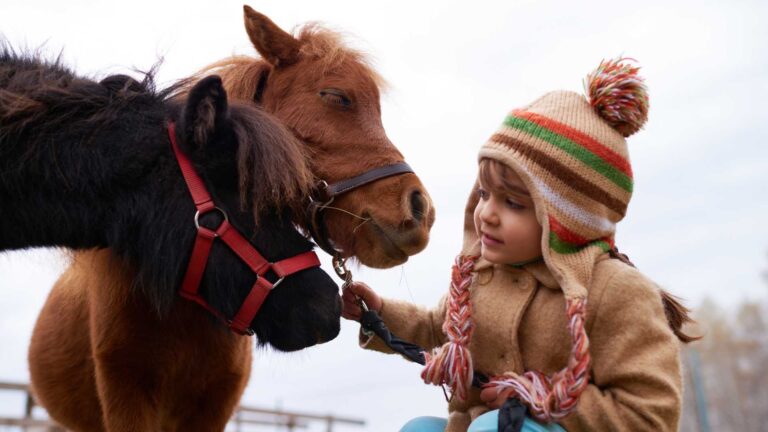What are the benefits of animal therapy in autism?
In recent years, the therapeutic benefits of animal-assisted interventions have gained significant attention, particularly animal therapy for autism spectrum disorder (ASD). As we explore innovative avenues to enhance the lives of individuals with autism, it becomes evident that the bond between animals and children transcends the ordinary.
There are several ways to treat autism, including ABA therapy. However, have you ever wondered what are the benefits of animal therapy in autism? Animal therapy can effectively help with a variety of medical, emotional, and developmental disorders, including those commonly experienced by individuals with autism.
Human-Animal Relationships Awareness Week, from November 12-18, is a timely reminder of the deep connections that can form between animals and individuals with autism. This week is an opportunity to acknowledge and appreciate the invaluable role that animals play in nurturing the social and emotional development of neurodiverse children.
The Human-Animal Bond Research Institute indicates positive advantages of animal therapy in autism. Findings demonstrate that interacting with animals enhances the engagement of neurodivergent individuals, fostering increased confidence and independence. In numerous instances, animal-assisted therapy has proven effective in improving communication skills for individuals on the spectrum.
Discover the benefits of combining animal therapy with ABA therapy and learn about the different approaches to animal therapy in autism by reading this informative blog post from ABA Centers of America.
Types of Animal Therapy in Autism
Dogs, cats, rabbits, and guinea pigs serve as more than adorable companions; they play a crucial role in supporting the social and emotional development of neurodiverse children. For those caring for a child with autism, it’s worthwhile to explore various types of animal therapy as alternative approaches to address the diverse characteristics of ASD.
1. Service Animals
Service animal therapy for children with autism involves incorporating specially trained animals, typically dogs, into therapeutic interventions to address the unique needs of individuals on the autism spectrum. This approach capitalizes on the proven benefits of the human-animal bond to enhance traditional therapeutic strategies.
Beyond the therapy sessions, the service animal becomes integral to the child’s daily life. The service animal can assist in practical tasks, fostering a sense of independence and routine for the child. This integration extends to public spaces, where the service animal’s presence helps the child navigate sensory challenges and promotes a sense of security.
The use of service animals in individuals with autism can offer a range of physical, emotional, and social benefits. Here are some key advantages:
- Provide emotional support
- Contribute to sensory integration
- Help with social interaction
- Nourish safety and assistance
- Reduce the feeling of loneliness
2. Emotional Support Animals
Emotional support animals (ESAs) are furry companions crucial in providing comfort and emotional assistance to individuals, including children with ASD. These animals, often dogs or cats, offer a unique form of support beyond traditional therapeutic methods. The presence of an ESA can have a positive impact on the emotional well-being of children with autism, helping to ease anxiety, provide companionship, and create a sense of security.
Integrating emotional support animals into treating autism involves recognizing their therapeutic benefits, as identified in the Journal of Alternative and Complementary Medicine. Unconditional love and nonjudgmental companionship can help children build social and emotional connections, reduce stress, and enhance overall well-being. The animal’s calming influence can also assist in managing sensory sensitivities commonly associated with autism.
3. Therapy Animals
Therapy animals, often dogs, horses, cats, birds, and even guinea pigs, are trained to offer comfort, companionship, and a unique connection that can be immensely beneficial in treating autism.
Therapy animals become part of a coordinated effort involving parents, therapists, and the animals themselves. Structured sessions may include grooming, playtime, or riding sessions with therapy horses. These interactions enhance social and communication skills, manage sensory sensitivities, and promote emotional well-being.
Other advantages encompass:
- Promoting social communication
- Enhancing engagement, responsiveness, and shared attention
- Assisting in the development of play skills
- Offering reinforcement and motivation during the learning process
- Serving as a physical outlet for self-regulation
- Alleviating emotional anxiety
- Enhancing the effectiveness of therapeutic experiences
4. Hippotherapy (Equine Therapy)
Hippotherapy, also known as equine therapy, is a specialized form of treatment that harnesses the unique movements of horses to address physical, occupational, and emotional challenges in individuals, including children with autism. In this therapeutic approach, the rhythmic and three-dimensional movements of the horse aim to promote sensory integration, improve posture, balance, and coordination, and enhance overall emotional well-being.
During hippotherapy sessions, the child engages in activities while on horseback, responding to the horse’s movements. These dynamic and rhythmic movements stimulate the child’s muscles and sensory systems, providing a unique and enjoyable way to work on physical and emotional challenges. The bond formed between the child and the therapy horse also plays a crucial role in fostering trust, confidence, and a sense of connection.
5. Pets
Introducing pets into the lives of families with children on the autism spectrum has shown to be a remarkably optimistic and therapeutic experience. The Journal of Autism and Developmental Disorders states that the unique bond between children with autism and their furry companions goes beyond mere companionship, offering a range of emotional, social, and developmental benefits. In this context, pets become household members and essential partners in a holistic approach to supporting children with autism.
You can find therapy animals at animal shelters, pet stores, or organizations. When selecting an animal to assist your child with autism, consider these guidelines:
- Introduce the animal to your child and observe their behavior and physical reactions. Look for signs of responsiveness and engagement to ensure a suitable match.
- Be attentive to any signs of intimidation from the child or the animal.
- Verify that the animal is calm, healthy, and alert.
- Aim for multiple interactions over time to assess compatibility.
Animal therapy in autism has the potential to bring about transformative experiences that contribute to improvements in everyday life.
ABA Therapy and Animal Therapy
Incorporating animal-assisted therapy (AAT) and ABA therapy for individuals with autism offers a holistic and synergistic approach to addressing a spectrum of needs. ABA therapy, known for its evidence-based strategies to modify behavior and teach essential skills, provides a structured framework for goal-oriented intervention.
ABA focuses on understanding and shaping behavior, often incorporating sensory integration techniques. The unique bond formed with animals can create a positive and motivating environment, complementing the systematic methods of ABA therapy.
ABA Centers of America Supports You!
In conclusion, combining animal therapy with evidence-based practices like ABA therapy presents a promising avenue for a more holistic approach to managing autism. Here at ABA Centers of America, with our roots in Massachusetts and New Hampshire, we take pride in navigating the ever-evolving landscape of autism intervention. Our commitment is reflected in our continuous exploration of innovative approaches, ensuring those seeking alternatives find the support and solutions they need.
Contact us today at (844) 923-4222 or visit our website to learn more about our comprehensive services and how ABA therapy can make a meaningful difference in individuals on the spectrum.
Together, let’s unlock the full potential of every neurodiverse child.







